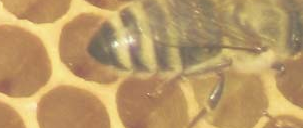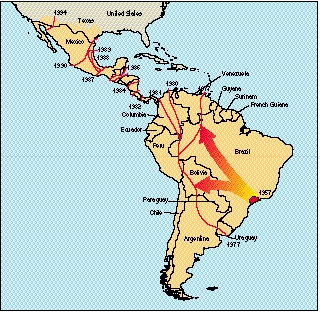
Killer bees are coming!! Yeah, we've been hearing that for 30 years now. Turns of a good cold winter stops them. So here's the latest.
What is a killer bee? (aka, Africanized honeybee)
African honey beeThere was this "genius" of a Brazilian
geneticist, Warwick Kerr, who got the bright idea to import them to the Americas in 1956.
His rationale was that if the tough African stock would breed with
gentle European honeybees, it would to produce a new breed of honey
bees, which would be less aggressive than the wild African bees but which would
be more productive than European honey bees (EHB) in Brazil's tropical
environment. . Kerr took 63 live queens from South African beekeepers
to a quarantine area at an agricultural research station near
Rio Claro, where 48 queens survived till the next year.

Breeding them with with European drones, Kerr and his associates produced a number of first generation hybrids, now known as Africanized honey bees, or more commonly as "killer bees" (Not to be confused with the late John Belushi). . Eventually their stock of Africanized honey bees was down to 29 which were kept in hive boxes equipped with queen excluders. These excluders are meant to keep the queens from exscaping the hive.
According to Kerr, in October of 1957, a local beekeeper (Marty Feldman, perhaps?) wandered by, noticed the queen excluders and removed them. That released 26 Africanized honey bee queens with small swarms into the nearby forest. Kerr hoped the escaped bees would either perish in the wild or mate with European honey bees and eventually lose their African characteristics. Yeah, right, Dr. Fraankestein. (Pronouces "Fronkensteen").
Of course, it wasn't but a few years after that when reports of wild bees aggressively and relentlessly attacking farm animals and humans began to surface inm the nearby areas. By the early 1960s, it was clear that the Africanized honey bees were moving quickly into other parts of the country and taking over from the gentle bees. Swarms of Africanized honey bees move 60 miles or more at a time rather than the 3 or 4 miles that a gentle honeybee moves, By October 1986, they reached Mexico.
Spread of Africanized Honey Bees in the United States.

The Africanized honey bee was first detected in the United States in 1990 in south Texas (Figure 2). For three years, their distribution was confined to the southern part of that state. In 1993, however, the AHB was detected in Arizona, and by 1995, they were detected in New Mexico and southern California. The bees then spread north, and by 1998 they were found in Nevada. In every state where they became established, the bees continued their migration northward over the next few years. By 2004, the bees had migrated through Texas and were detected in the southern most counties of Oklahoma.
For reasons that are yet unclear, the eastward spread of the AHB stalled in Texas for many years. This unexpected break in home-range expansion was hypothesized to be a result of climate or other ecological factors. Nonetheless, by 2005 the AHB expanded eastward from Houston. Most recently, the AHB has become established in western Louisiana, southwestern Arkansas, and southern Florida (Figure 2). It remains unclear how the AHB entered Florida, given the lack of positive AHB findings along the gulf coast, thus it seems likely that the bees were independently introduced on cargo ships through commercial shipping ports.
What to expect in the future
It appears that the cold winters or other factots have largely constrined the bees to their current areas, with occassional forays beyond.
What to do if attacked by Africanized bees
Remember these important steps:
- RUN away quickly. Do not stop to help others. However, small children and the disabled may need some assistance.
- Beleive it or not, the USDA next recommends that "As you are running, pull your shirt up over your head to protect your face, but make sure it does not slow your progress. This will help keep the bees from targeting the sensitive areas around your head and eyes." OK, running while pulling a shirt over your face. Not likely to work well.
- Continue to RUN. Do not stop running until you reach shelter, such as a vehicle or building. A few bees may follow you indoors. However, if you run to a well-lit area, the bees will tend to become confused and fly to windows.Do not jump into water! The bees will wait for you to come up for air. If you are trapped for some reason, cover up with blankets, sleeping bags, clothes, or whatever else is immediately available.
- Do not swat at the bees or flail your arms. Bees are attracted to movement and crushed bees emit a smell that will attract more bees.
- Once you have reached shelter or have outrun the bees, remove all stingers. When a honey bees stings, it leaves its stinger in the skin, which continues to pump venom into its victim.
- Do not pull stingers out with tweezers or your fingers. This will only squeeze more venom into the wound. Instead, scrape the stinger out sideways using your fingernail, the edge of a credit card, a dull knife blade or other straight-edged object.
- If you see someone being attacked by bees, encourage them to run away or seek shelter. Do not attempt to rescue them yourself. Call 911 to report a serious stinging attack. The emergency response personnel in your area have probably been trained to handle bee attacks.
- If you have been stung more than 15 times, or are feeling ill, or if you have any reason to believe you may be allergic to bee stings, seek medical attention immediately. The average person can safely tolerate 10 stings per pound of body weight. This means that although 500 stings can kill a child, the average adult could withstand more than 1100 stings.
References
- USDA Invasive Species info
- USDA Arizona
-
Columbia University
- USGS maps
- The University of Arizona, Africanized Honey Bee Education Project. Africanized Honey Bees on the Move: Lesson Plans
- Invasive Species, Africanized Honey Bee Profile
- "Africanized Honey Bees." The Texas A&M University Agriculture Program.